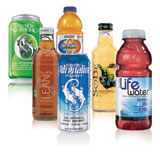Blog
What number of beverage choices are too many?
How many beverage options are too many?

Consider
the packaging materials, shapes, flavors and benefits offered by today’s
non-alcoholic beverages. (Four materials) X (10 shapes) X (20+ flavors) X (20+
benefits) = at least 16,000 options in convenience stores alone. Shoppers can
choose to drink to and/or for their health. They can imbibe power, fun, stress
relief, cancer-fighting anti-oxidants, fusion, energy, mental alertness,
pro-biotic health and, of course, thirst-quenching flavor. Shoppers can get an
adrenalin rush from SoBe or a spicy hot way to drink veggies from V8. Vitamin
Water offers Fierce (for hurricanes?) and Rain (for dry spells?). Energy drinks
offer to make them feel like a Tiger, a Red Bull, a Monster, a GOAT, an Amp or
a Rock Star, depending on their mood.
Flavor and color
choices are as mind-boggling as the bottle shapes and benefits. Pom bottles are
short and chubby. Red Bull cans are tall and slender. The proliferation of
package designs has kept pace with the proliferation of benefits. A plastic
bottle is not just a plastic bottle any more. It is smooth or swirled, straight
or slope-sided, quart or liter measures, round or square, transparent or fully
dressed. There is colorful artistry from Arizona Tea, whimsy from Odwalla and
shapely elegance from Tropicana’s new Pure (are older varieties impure?).
Counting
varieties of teas, juices, smoothies, coolers and slushies is a new way to go
to sleep.
Thanks to growing attention to recycling, and
conversion into actual products like tote bags, single-serve bottles are being
environmentally accepted as responsible parts of today’s portable but still
eco-concerned lifestyle. One of our shoppers writes: “A year ago, I was trying
to avoid plastic and buy things in glass. Now I’m trying to use more plastic
bottles and jars because they are light, save transportation costs, and are
finding their way into new products.”
Another has a
different view: “Cans are usually 100% recyclable, but I don’t like to drink
directly out of a can so I use a straw. So far, straws are not recyclable, but
I frequently reuse my straw. Bottles are usually recyclable, but their caps are
not. Boxes usually go into the trash. So, in my opinion, cans are probably the
most “green”, followed closely by bottles. Boxes come in last place.” (So much
for hard-to-find Fizzies drink tablets, and the new, lighter-to-ship wine boxes
that some consumers are buying to be green as well as thrifty.)
The
fact that long-booming sales of beverages have started to slip at convenience
stores is being attributed to sticker shock for gas, which keeps some drivers
from going into the store to spend even more. Ballooning variety may have
become another barrier, passing the point at which consumers can make choices
that satisfy them in an acceptable amount of time. Choosing the combo that
addresses the needs of the moment may have become just too much trouble. F&BP

